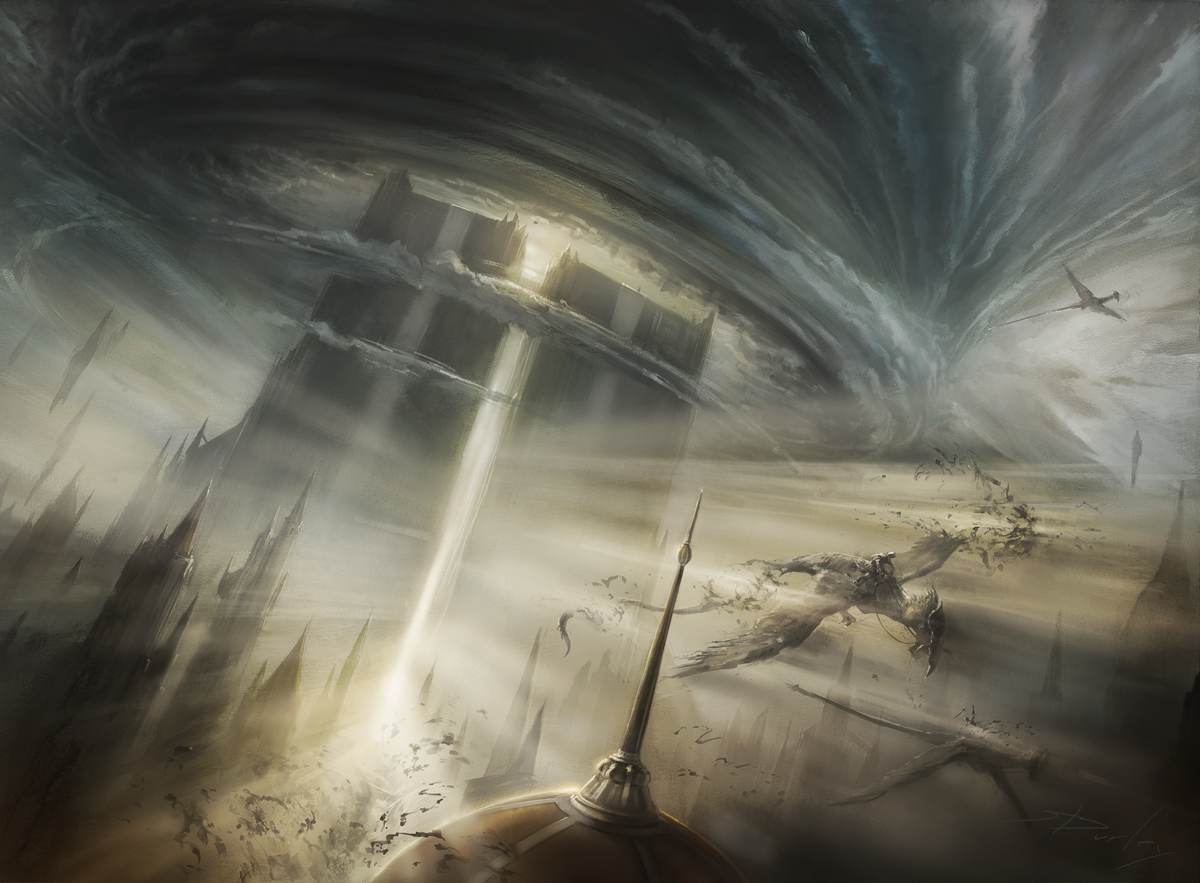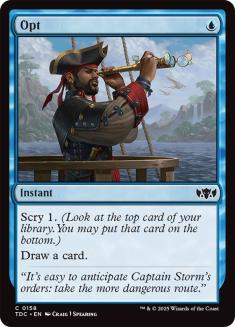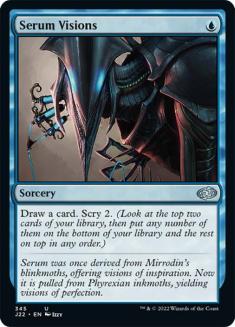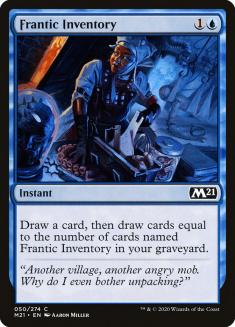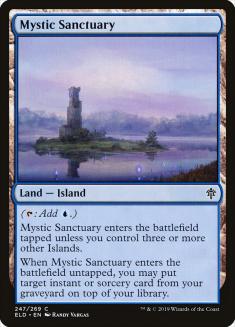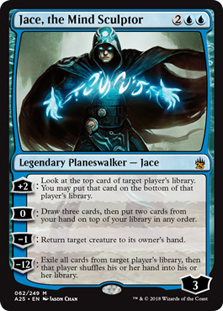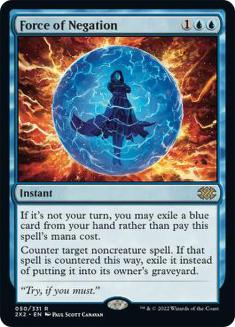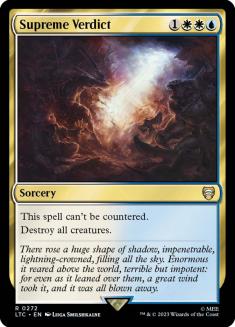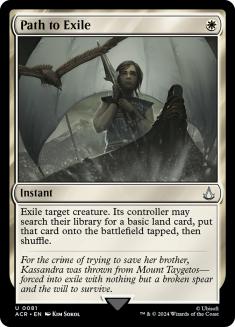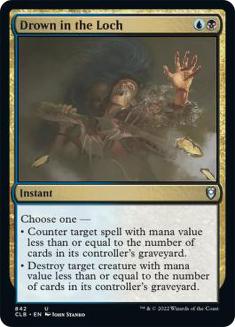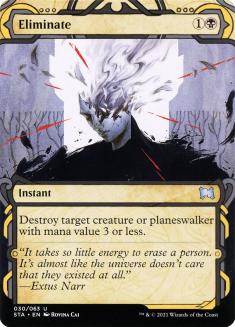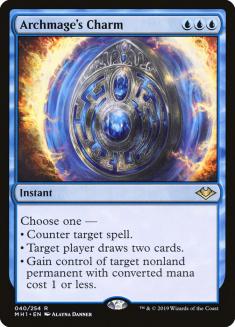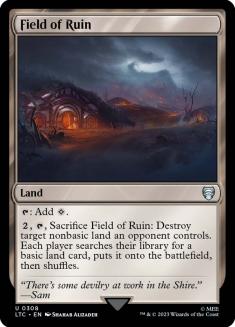Outside of Legacy, cheap card draw has been plagued by mediocrity in each of the competitive formats. In Pioneer, Dig Through Time is still mistakenly legal; however, it does not do us much good on the first two turns. Cheap card draw was the cornerstone for control in the ancient times, helping to guarantee early land drop hits while providing late-game relevancy at the same time.
Opt is the gold standard for control in Modern, handily replacing Serum Visions soon after it entered the format. I would have long debates with other Modern enthusiasts on social media, as many of folks believed the sorcery-speed option was superior. There is no universe where the additional scry, after already drawing a card, was worth the instant-speed sacrifice. Control, especially in older formats, requires a reactive element to remain competitive.
I would like nothing more than to tap out every turn for a planeswalker or sweeper, but that’s not feasible in the world we play in. Punishment for not having at least the threat of disruption is damning and it forces us to play cards that may be worse than their sorcery-speed counterparts. Life has been easier since I came to grips with that. Once Opt was introduced to Modern, Azorius Control had a huge boost from the days of Serum Visions. With the release of Frantic Inventory, another, much bigger boost has launched control forward.
Creatures (4)
Lands (17)
Spells (39)

GerryT recently wrote an article that declared Dimir Control the best control deck in Modern. In that piece, he looks at a build that had some Magic Online success and identifies its strengths well, and I agree with most of his analysis. The “draw-go” deck is a representation of a time where control Magic was at an all-time high. I played casually back then, running no win conditions other than a Rainbow Efreet, and it was glorious. This Dimir Control deck tries to get back to that style of gameplay, leaning on a combination of Shark tokens and Snapcaster Mages to close out the game. With win conditions this light, Dimir Control must have the most dominant spell suite in control’s Modern history to deliver.
It all starts with Frantic Inventory, the best card draw spell control has seen in years. I’ve written tons of content, including social media rants, showcasing the card’s superior design compared to its competitors the moment it was previewed. It is not a card that will ever need to be banned; instead it exemplifies a perfect card design that worked then as well as it works now. The initial mana investment for this cantrip is pricey, but further copies provide a fruitful award. In this Dimir Control deck, Thought Scour can often create a bigger Frantic Inventory right from the start.
Thought Scour is not used enough in Modern. Once Opt became mainstream, I became complacent with the one-mana cantrip and assumed it was solved. Thought Scour was in my combo decks, as well as control decks that utilized Uro, Titan of Nature Wrath, but never in decks that just had Snapcaster Mage and Mystic Sanctuary as the payoff cards. With just those two options, Opt is still the correct card draw spell of choice, but Dimir has so much more. In addition to Frantic Inventory, Logic Knot and Drown in the Loch provide big rewards for big graveyards on both sides. In Dimir Control it makes sense, but we will be exploring a possible Azorius Control deck that can also take advantage of that effect.
In Standard, Frantic Inventory is great without trying to break it. In Modern, we have a much deeper card pool to extract full value out of each card. The moment I saw Frantic Inventory, I knew Mystic Sanctuary would create some game-ending scenarios with a couple of copies of Frantic Inventory in the graveyard. All of this is achieved with a Flooded Strand in the late-game, creating flood protection like we have never seen before. Having a fetchland on the battlefield was already a powerful effect with Cryptic Command, but this makes it even more deadly. With Cryptic Command, you’re locked into a one-spell turn, whereas with Frantic Inventory the cheap mana cost allows for a second spell to be used.
With this arsenal of power control instants, I have no doubt in my mind that Dimir Control is a legitimate powerhouse in Modern. For all the reasons Gerry laid out, I would not fault any control fan for taking this deck through the competitive gauntlet. Dimir Control being the best control deck in Modern is the only piece I disagree with Gerry on.
As he mentions at the end of his article, Teferi, Time Raveler on the battlefield can be problematic for the game-plan of Dimir Control. Going even farther than that, Teferi remaining on the battlefield is game-ending for most of the non-aggro decks in the format. There’s a reason that players cannot wait for rotation and it’s not just to see Wilderness Reclamation exit Standard. Teferi has broken hundreds of strategies by simply existing, providing a static ability that should be much more expensive to achieve. For just three mana, this planeswalker ends instant-speed play for the opponent until it’s removed. That type of power will not remain contained in Standard and it has quickly become a Modern mainstay.
If Teferi did not exist, then I would be all-in on the Dimir Control train. I have already taken it out for a spin and loved it, so expect to see me eventually use a deck like this in a premier event. Right now, there’s a superior control option and it’s the same one that the Modern community loves to hate.
Creatures (4)
Planeswalkers (8)
Lands (24)
Spells (24)

Unlike the Dimir Control deck Gerry wrote about, Azorius Control lowers its shields on Turn 3 and Turn 4 for the dynamic planeswalkers of Modern. Teferi may be the best three-mana planeswalker of all time, but Narset, Parter of Veils is no slouch either. Another brutal static ability, it reduces opponents to drawing no more than one card a turn. This planeswalker also produces the perfect two cards from the top eight cards of the library. Tapping out is always scary; however, these two planeswalker add a punishing element that can outweigh the threat produced by the opponent on the following turn.
On Turn 4, Jace, the Mind Sculptor and Supreme Verdict are the sorcery-speed cards. Each are worth the sacrifice of tapping out and produce an exorbitant advantage in their respective matchups. The overall premise that the “draw-go” nature of Dimir Control makes it superior is false in light of the stated strength of tap-out spells, as well as the existence of Force of Negation.
Force of Negation is what allows us to tap all our mana without fear of retribution. It’s not exactly Force of Will, but it’s good enough to never leave my control builds in Modern. There was a great amount of play and risk associated with a Jace, the Mind Sculptor on Turn 4. I would end up having to craft alternative play patterns to fend off the various non-creature destruction I would face when tapping out for the greatest of all-time.
With Force of Negation, that dynamic changed for the better and control play became a bit easier. In Dimir Control, it serves as a free counterspell when mana is tied up from a different piece of disruption. When using Force of Negation in Azorius Control, it’s a defensive piece after serving the opponent a deadly planeswalker the turn before. The latter is a much more effective and powerful use of the spell and makes the planeswalker suite that much better.
While deciding which control strategy is superior, the play patterns are not the only points to explore. Sometimes, one color has better spells than the other in a category. White-based removal has not changed in Modern, with Path to Exile and Supreme Verdict running the show. That combination has been around for a long time, giving other decks in the format a public enemy to build around. Path to Exile is a removal spell that we all hate to use early, but the option to hold back is usually not there. With the release of Fatal Push, black has the best removal the format has to offer.
The advantage of Fatal Push is not absolute, as Path to Exile hits expensive threats. Since the format is very quick, this usually does not punish those that choose to go with black-based removal. Primeval Titan and the large Eldrazi are the main cast of characters that can give black removal spells a hard time, especially when using Eliminate, Drown in the Loch, and Fatal Push. Each of those removal spells is better against more matchups than Path to Exile and Supreme Verdict, but the range of the white removal spells is larger.
The issue has always been quantity with spot removal spells from white. There is only Path to Exile, as the alternatives are much weaker. Winds of Abandonment, Oust, and Condemn have all been in and out of my control decks over time, but I have found it more effective to completely lean on Path to Exile. With black options, you can mix and match the removal spells because they’re all very good against most decks. Even though black has the best removal, the range that Path to Exile provides may make this category too close to call.
Play patterns and removal are starkly different between these two options, but the disruption is nearly identical. Even with access to black, Dimir Control is not interested in Thoughtseize. It focuses completely on the blue-based answers to enemy spells, making the core of each deck very similar. Each deck takes full advantage of the Mystic Sanctuary and Cryptic Command duo that has dominated Modern in different decks for the last year.
I had Archmage’s Charm in Azorius Control, but I removed it very quickly. With Frantic Inventory and the planeswalker package, card advantage was never an issue for me. Using Archmage’s Charm in Azorius Control, as well as Dimir Control, felt too close to Cancel. The other counterspells in each list are great and I’m also as excited as Gerry is to play Spell Snare. With no shortage of targets in the format, it’s an easy card to include moving forward.
The final piece to compare is the mana. With both decks being only two colors, the manabase is completely sound with room to spare. Dimir only plays 23 lands, making it tough to fit more Field of Ruin in there. Gerry tossed another copy in his version from the original, bringing it to two, but that’s still a couple short from optimal in my eyes. There’s no way I would play a deck in a format with the Urzatron legal without four copies Field of Ruin; that was a huge deal-breaker for me and immediately knocks a few points off the power level of Dimir Control.
I do not care how powerful the flash elements of Dimir Control are, because without Field of Ruin disrupting big mana early, the Eldrazi will come and feast upon you. Control used to be a bye for big mana decks, until Wizards of the Coast printed the land answer of our dreams.
The other big difference is having Celestial Colonnade, where Dimir Control does not have a creature-land. If I were to play it, there would be a couple of copies of Creeping Tar Pit. The one-mana spells in the deck are minimal and the payoff of having the option of attacking down a planeswalker or life total is huge. Not having them in the deck is too purist for me, tunnel-visioning to the reactive dream.
In my final analysis, both decks are very good. Azorius Control edges Dimir Control on power level and universal answers, through Path to Exile and phenomenal planeswalker abilities. Even if you were to build Dimir Control with more copies of Field of Ruin, it would still fall behind in those two areas by a significant margin. Although Dimir Control wins on the removal front in most matchups and has a smoother reactive play pattern attached, it can easily get overwhelmed by wide and/or big strategies. Dimir Control is good, but Azorius Control is best.

